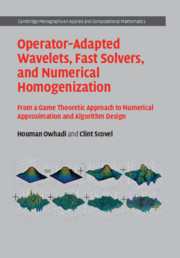 Operator-Adapted Wavelets, Fast Solvers, and Numerical Homogenization
Operator-Adapted Wavelets, Fast Solvers, and Numerical Homogenization Book contents
- Frontmatter
- Dedication
- Contents
- Preface
- Acknowledgements
- Reading Guide
- 1 Introduction
- Part I The Sobolev Space Setting
- 2 Sobolev Space Basics
- 3 Optimal Recovery Splines
- 4 Numerical Homogenization
- 5 Operator-Adapted Wavelets
- 6 Fast Solvers
- Part II The Game Theoretic Approach
- Part III The Banach Space Setting
- Part IV Game Theoretic Approach on Banach Spaces
- Part V Applications, Developments, and Open Problems
- Part VI Appendix
- Bibliography
- Algorithms
- Glossary
- Nomenclature
- Index
- Identities
6 - Fast Solvers
from Part I - The Sobolev Space Setting
Published online by Cambridge University Press: 10 October 2019
- Frontmatter
- Dedication
- Contents
- Preface
- Acknowledgements
- Reading Guide
- 1 Introduction
- Part I The Sobolev Space Setting
- 2 Sobolev Space Basics
- 3 Optimal Recovery Splines
- 4 Numerical Homogenization
- 5 Operator-Adapted Wavelets
- 6 Fast Solvers
- Part II The Game Theoretic Approach
- Part III The Banach Space Setting
- Part IV Game Theoretic Approach on Banach Spaces
- Part V Applications, Developments, and Open Problems
- Part VI Appendix
- Bibliography
- Algorithms
- Glossary
- Nomenclature
- Index
- Identities
Summary
By representing the operator as independent, sparse, well-conditioned linear systems, theoperator-adapted wavelet (gamblet) transform of the previous chapter naturally leads to a scalable linear solver with some degree of universality. The near-linear complexity of the solver and the Fast Gamblet Transform are based on the nesting, exponential localization, and Riesz stability of the underlying wavelets. The representation of the Green's function in the basis formed by these wavelets is sparse and rank-revealing.The algorithm isillustrated through a numerical application toa second-order divergence form elliptic operator with rough coefficients.
Keywords
- Type
- Chapter
- Information
- Operator-Adapted Wavelets, Fast Solvers, and Numerical HomogenizationFrom a Game Theoretic Approach to Numerical Approximation and Algorithm Design, pp. 90 - 102Publisher: Cambridge University PressPrint publication year: 2019
